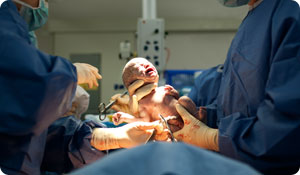
The United States cesarean section rate has skyrocketed from 5% in 1970 to over 31 percent in 2007. Are we saving more mothers and babies? Unfortunately, no and in fact, the opposite is true. More women and babies are experiencing complications from cesarean sections, the most common surgery in the US. Fortunately, women's health officials are addressing this alarming trend with new guidelines for c-sections.
There are many reasons why c-section rates are so high, including:
- Obesity and associated complications such as hypertension and diabetes
- Older mothers having babies
- More twins and triplets from infertility treatments
- More inductions of labor
- More fetal heart monitoring during labor which leads to frequent misdiagnosis of fetal distress.
The biggest increase in C-sections however, came from the American Congress of Obstetricians and Gynecologists (ACOG) guidelines that severely restricted vaginal birth after cesarean (VBAC). If a woman had one C-section, most doctors insisted all her other children be delivered by C-section too.
VBACs are associated with a less than 1 percent risk for uterine rupture along the previous c-section scar. This can be a life-threatening emergency for the mother and baby. Cesarean section is major abdominal surgery, though, and comes with its own risks. Studies show the risks for C-section often outweigh the benefits of banning VBACs. In addition, many mothers felt doctors were forcing them to have unwanted surgeries.
With all major health authorities including the World Health Organization, American Medical Association, and even ACOG recognizing that C-section rates were unreasonably high, ACOG reconstructed safe guidelines to bring unnecessary c-sections under control.
New guidelines released in July 2010, make room for VBACs as well as vaginal twin deliveries (previously delivered almost exclusively by c-section). C-section guidelines now say that these patients are now considered appropriate candidates for TOLAC (trial of labor after cesarean):
- Women with two previous low-transverse cesarean incisions (standard in most c-sections)
- Women carrying twins
- Women with an unknown type of uterine scar (for example, women who come from other countries and don't have their medical records)
ACOG advises physicians to counsel patients about risks and benefits associated with VBAC or vaginal twin delivery and to make decisions with their patient about how to approach labor.
ACOG says the risk of uterine rupture during a TOLAC is low-between 0.5 and 0.9 percent-but if it occurs, it can be very serious. TOLAC is most safely undertaken where staff can immediately provide an emergency cesarean, but ACOG recognizes that may not be universally available. Their intent is to provide the safest possible health care for laboring women and not to force women to have surgery against their will. They also recognize that women are entitled to make their own choice about how they want to deliver their baby, once they are aware of the risks.
But what if doctors and patients disagree? ACOG guidelines say that if, during prenatal care, a physician is uncomfortable with a patient's desire to undergo VBAC, it is appropriate to refer her to another physician or health center. Similarly, if a patient wants a VBAC but her physician is unsupportive, she can make the switch to a different health care provider.
These new C-section guidelines aim to make childbirth a safer experience for mothers and babies while simultaneously working to reduce unsafe c-section rates.
Sources:
American Congress of Obstetricians and Gynecologists
Ob-Gyns Issue Less Restrictive VBAC Guidelines
July 21, 2010
http://www.acog.org/from_home/publications/press_releases/nr07-21-10-1.cfm





